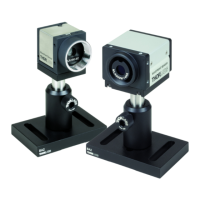© 2007-2012 Thorlabs GmbH
34 WFS Series
is indicating the spherical wavefront.
c) A movement of the lens towards the light source will generate a converging beam
decreasing its diameter on the way to the Wavefront Sensor. When the
Wavefront Sensor would be replaced by a canvas, a focal point would be seen
somewhere behind the sensor position. This makes clear that the wavefront
before was also spherical but is now displayed spherical concave.
Such an example setup can be used to check the quality of optical fiber collimators.
During manufacturing the correct position of the collimation lens is adjusted until the
measured wavefront becomes flat and the calculated Zernike coefficient Z
5
describing 'Defocus' becomes zero (Z
5
= 0). This procedure is faster and much
more precise than the conventional method using a Beam Profiler which is moved
back and forth in order to ensure a constant beam diameter.
4.1.1
WFS10 Highspeed Mode
Fast Wavefront Sensor instruments (WFS10) are based on a much faster CMOS
camera compared to the WFS instruments which are based on a CCD camera.
Besides the higher achievable frame rate in Normal Mode an even higher
measurement speed is available in Highspeed Mode.
Please note, that a CMOS sensor may have more "hot pixels" (pixels showing a
certain intensity even with camera darkened) than CCD sensors. See chapter Hot
Pixel for details.
What is Highspeed Mode?
Normally, the complete spotfield image is transmitted from the camera to the
computer and interrogated there. This method is speed limited because of the
available USB 2.0 bandwith and the calculation speed of the PC.
Compared to Normal Mode there are a number of differences in Highspeed
Mode:
The spotfield image is captured inside the camera but not transmitted via USB.
Instead, the camera's DSP is calculating the spot centroid coordinates. Due to
this internal calculations, the pupil center may shift slightly, when switching from
normal to high speed mode.
Only the calculated centroid positions are transmitted via USB.
Much lower volume of transmitted data increases maximum measurement rate.
On the other side, the PC is freed from time-consuming centroid calculations so
that further calculations (wavefront, Zernike fit) speed up.
That is, entering Highspeed Mode enables one important advantage:
higher measurement speed, especially at large camera resolutions
but also brings along some restrictions and disadvantages:
Centroid calculation windows are no more dynamically positioned but are
placed on a semi-rigid grid.
This calculation grid will be configured each time you enter Highspeed Mode
and is fixed afterwards.
1
20

